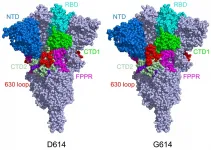Nanotech scientists create world's smallest origami bird
2021-03-17
(Press-News.org) ITHACA, N.Y. - If you want to build a fully functional nanosized robot, you need to incorporate a host of capabilities, from complicated electronic circuits and photovoltaics to sensors and antennas.
But just as importantly, if you want your robot to move, you need it to be able to bend.
Cornell researchers have created micron-sized shape memory actuators that enable atomically thin two-dimensional materials to fold themselves into 3D configurations. All they require is a quick jolt of voltage. And once the material is bent, it holds its shape - even after the voltage is removed.
As a demonstration, the team created what is potentially the world's smallest self-folding origami bird. And it's not a lark.
The group's paper, "Micrometer-sized electrically programmable shape memory actuators for low-power microrobotics," published in Science Robotics and was featured on the cover. The paper's lead author is postdoctoral researcher Qingkun Liu.
The project is led by Itai Cohen, professor of physics, and Paul McEuen, the John A. Newman Professor of Physical Science.
McEuen and Cohen's ongoing collaboration has so far generated a throng of nanoscale machines and components, each seemingly faster, smarter and more elegant than the last.
"We want to have robots that are microscopic but have brains on board. So that means you need to have appendages that are driven by complementary metal-oxide-semiconductor (CMOS) transistors, basically a computer chip on a robot that's 100 microns on a side," Cohen said.
Imagine a million fabricated microscopic robots releasing from a wafer that fold themselves into shape, crawl free, and go about their tasks, even assembling into more complicated structures. That's the vision.
"The hard part is making the materials that respond to the CMOS circuits," Cohen said. "And this is what Qingkun and his colleagues have done with this shape memory actuator that you can drive with voltage and make it hold a bent shape."
The machines fold themselves fast, within 100 milliseconds. They can also flatten and refold themselves thousands of times. And they only need a single volt to be powered to life.
The team has already been recognized by Guinness World Records for creating the smallest walking robot. Now, they hope to capture another record with a new self-folding origami bird that is only 60 microns wide.
The team is currently working to integrate their shape memory actuators with circuits to make walking robots with foldable legs as well as sheet-like robots that move by undulating forward. These innovations may someday lead to nano-Roomba-type robots that can clean bacterial infection from human tissue, micro-factories that can transform manufacturing, and robotic surgical instruments that are ten times smaller than current devices, according to Cohen.
INFORMATION:
Support was provided by the U.S. Army Combat Capabilities Development Command's Army Research Laboratory, the National Science Foundation, the Cornell Center for Materials Research, the Air Force Office of Scientific Research, and the Kavli Institute at Cornell for Nanoscale Science. Part of the work was performed at the Cornell NanoScale Science and Technology Facility.
-30-
ELSE PRESS RELEASES FROM THIS DATE:
2021-03-17
The coronavirus' structure is an all-too-familiar image, with its densely packed surface receptors resembling a thorny crown. These spike-like proteins latch onto healthy cells and trigger the invasion of viral RNA. While the virus' geometry and infection strategy is generally understood, little is known about its physical integrity.
A new study by researchers in MIT's Department of Mechanical Engineering suggests that coronaviruses may be vulnerable to ultrasound vibrations, within the frequencies used in medical diagnostic imaging.
Through computer simulations, the team has modeled the virus' mechanical response to vibrations across a range of ultrasound ...
2021-03-17
A new study has found that about 35% of Americans with a cancer history had an elevated risk of cardiovascular disease in the next decade, compared with about 23% of those who didn't have cancer.
Based on a risk calculator that estimates a person's 10-year chances of developing heart disease or stroke, researchers from The Ohio State University found that the average estimated 10-year risk for a cancer survivor was about 8%, compared to 5% for those who didn't have a history of cancer.
The new study appears in the journal PLOS ONE.
"We know that obesity, cancer and cardiovascular disease share some common risk factors, and in addition to those shared risk factors, cancer patients also receive treatments including radiation and chemotherapy that can affect their cardiovascular ...
2021-03-17
Many people have never heard of Brucellosis, but farmers and ranchers in the United States forced to cull animals that test positive for the disease and people infected by the animal-transmitted Brucella abortus (B. abortus) pathogen that suffer chronic, Malaria-type symptoms, certainly have.
Brucellosis is an agricultural and human health concern on a global scale. It was introduced over 100 years ago to Bison and elk in Yellowstone National Park by cattle and has been circulating among the wild herds ever since, leading to periodic outbreaks and reinfection. There is no vaccine for humans, and experimental studies ...
2021-03-17
GRAND RAPIDS, Mich. (March 16, 2021) -- Older age at the time of conception and alcohol consumption during pregnancy have long been known to impact fetal development.
Now, a new report published in Proceedings of the National Academy of Sciences suggests older age and alcohol consumption in the year leading up to conception also may have an impact by epigenetically altering a specific gene during development of human eggs, or oocytes.
Although the study did not determine the ultimate physical effects of this change, it provides important insights into the intricate relationship between environmental exposures, genetic regulation and human development.
"While the outcome of the change isn't clear, our findings give us a valuable look into ...
2021-03-17
BOSTON - March 16, 2021 - The fast-spreading UK, South Africa, and Brazil coronavirus variants are raising both concerns and questions about whether COVID-19 vaccines will protect against them. New work led by Bing Chen, PhD, at Boston Children's Hospital analyzed how the structure of the coronavirus spike proteins changes with the D614G mutation -- carried by all three variants -- and showed why these variants are able to spread more quickly. The team reports its findings in Science (March 16, 2020).
Chen's team imaged the spikes with cryo-electron microscopy (cryo-EM), ...
2021-03-17
Scientists at the U.S. Department of Energy's Ames Laboratory and their partners from Clemson University have discovered a green, low-energy process to break down polystyrene, a type of plastic that is widely used in foam packaging materials, disposable food containers, cutlery, and many other applications.
Polystyrene is part of a much larger global plastic waste problem. Hundreds of millions metric tons of polymers are produced each year, a large majority of which is discarded after use. Due to the chemical stability and durability of industrial polymers, plastic waste does not easily degrade in landfills and is often burned, which produces carbon dioxide and other hazardous gases. ...
2021-03-17
Combining tissue engineering and regenerative medicine, scientists have fabricated a series of heart valve replacements with the ability to incorporate host cells, enabling them to regenerate and grow over time. The valves expanded and maintained their function for a year when implanted into growing lambs, suggesting they could address the dire need for a long-term valve replacement for children with congenital heart disorders. These pediatric patients depend on mechanical or prosthetic heart valves for survival, but current devices often calcify over time and cannot grow alongside the ...
2021-03-17
WASHINGTON-- The stormy, centuries-old maelstrom of Jupiter's Great Red Spot was shaken but not destroyed by a series of anticyclones that crashed into it over the past few years.
The smaller storms cause chunks of red clouds to flake off, shrinking the larger storm in the process. But the new study found that these disruptions are "superficial." They are visible to us, but they are only skin deep on the Red Spot, not affecting its full depth.
The new study was published in the Journal of Geophysical Research: Planets, AGU's journal for research on the formation and evolution of the planets, moons and objects of our solar system and beyond.
"The intense vorticity of the [Great Red Spot], together with its larger size and depth compared to the interacting vortices, ...
2021-03-17
Toronto, ON -A new study published in the journal Substance Use and Misuse has found that adverse childhood experiences, such as physical and sexual abuse and neglect, predict greater performance-enhancing substance use in young adults.
Analyzing a sample of over 14,000 U.S. young adults from the National Longitudinal Study of Adolescent to Adult Health, researchers found that adverse childhood experiences are strongly associated with both legal (e.g., creatine monohydrate) and illegal (e.g., anabolic-androgenic steroids) performance-enhancing substance use. This relationship was especially strong among individuals who experienced ...
2021-03-17
(March 17, 2021) -- Eric Shattuck, assistant professor of research in the UTSA Institute for Health Disparities Research (IHDR) at The University of Texas at San Antonio, is studying the phenomenon of social distancing in response to infectious disease and its effects on pathogen transmission and the health of individuals and communities.
Many animals, including humans, exhibit behavioral changes during the early stages of an infection, including reduced social contacts, called sickness behavior. His findings suggest innate social distancing might help prevent the infection ...
LAST 30 PRESS RELEASES:
[Press-News.org] Nanotech scientists create world's smallest origami bird


